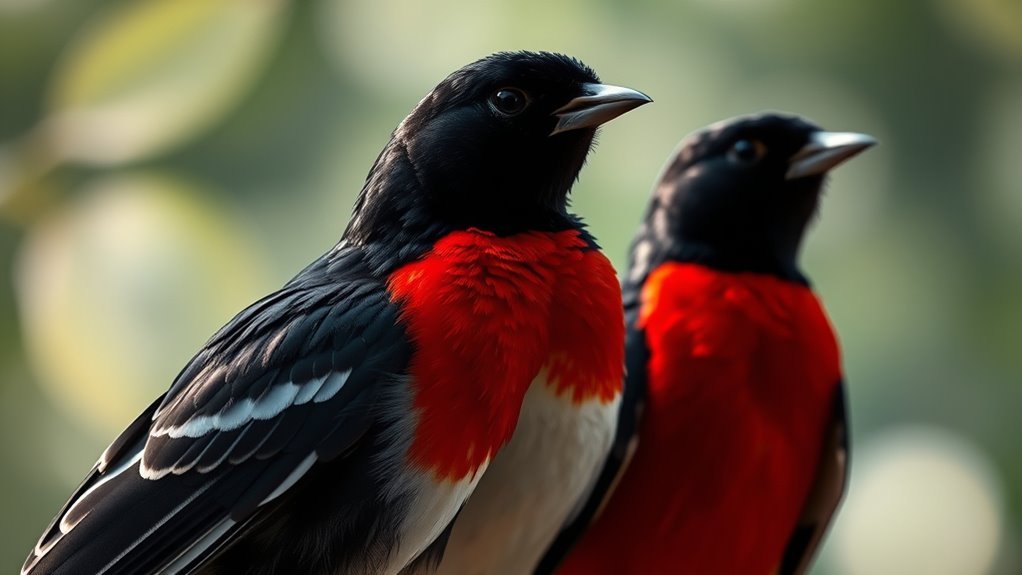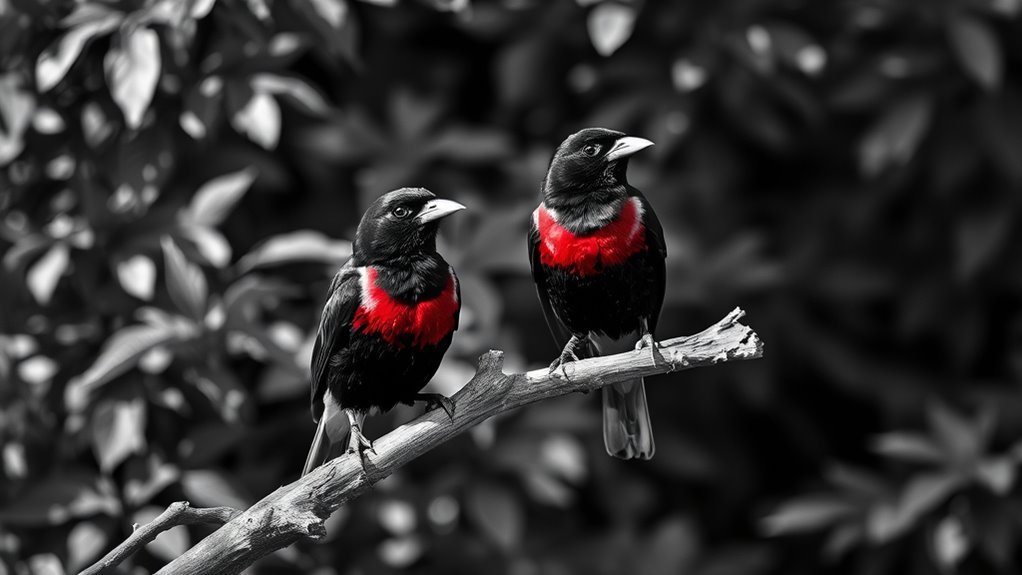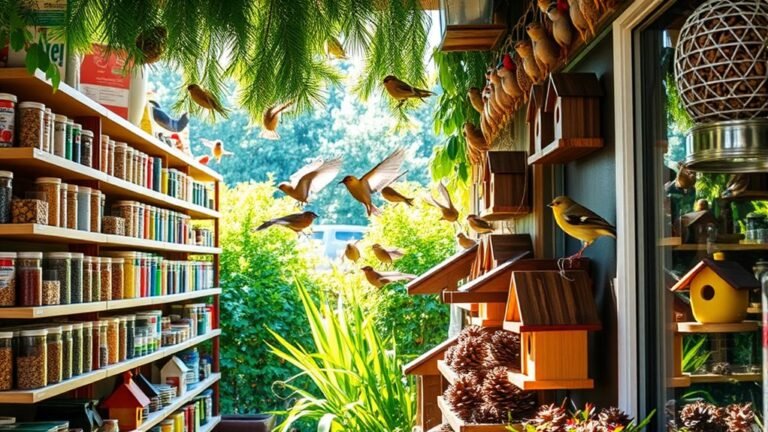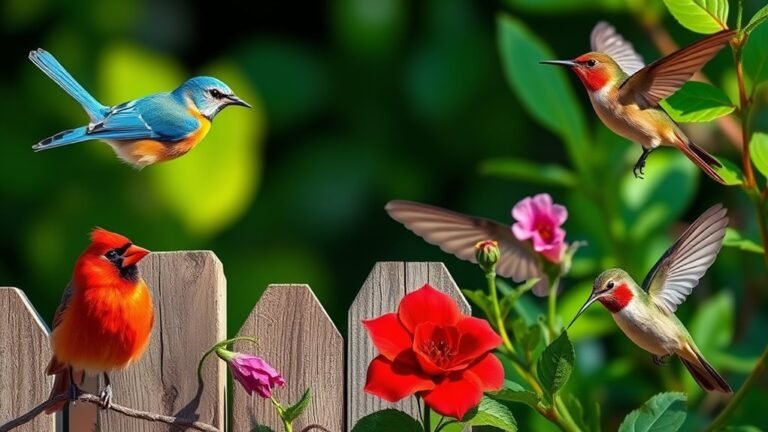Black and White Birds With Red Chests: Identification Guide
When you see black and white birds with bright red chests, it is important to identify them correctly. Their clear color patterns and unique calls, like cheerful whistles or quick chirps, make them easy to recognize. By learning about their feeding habits and the places they like to visit, you can improve your chances of spotting these fascinating birds in your backyard. Do you want to learn which traits help you tell them apart and ways to attract them to your space?
Key Takeaways
- Look for contrasting black and white feathers paired with bright red chests for easy identification of species like the Eastern and Western Black Redstart.
- Listen for distinctive sounds; they produce beautiful whistles and sharp chirps that help differentiate between species.
- Pay attention to behavior: Eastern Black Redstarts are energetic during courtship, while Western Black Redstarts have a calmer demeanor.
- Recognize feeding habits; some species prefer foraging in treetops, while others search for insects on the ground.
- Familiarize yourself with their habitats, such as forests and urban parks, to increase your chances of sighting these birds.
Characteristics of Black and White Birds With Red Chests

When you see black and white birds with bright red chests, you can spot several key traits that distinguish them. Their feathers often show a clear contrast; the black and white colors highlight their bright red chests, making them easy to recognize.
Additionally, these birds have unique sounds. Their calls include beautiful whistles and sharp chirps, which help them communicate, especially during mating season.
Noticing these features can make your birdwatching more enjoyable. Each sighting can increase your knowledge about birds and help you connect with other birdwatching fans.
Enjoy the experience of seeing these striking birds in nature.
Common Species Overview
As you observe black and white birds with red chests, you'll see notable species like the Eastern Black Redstart and Western Black Redstart.
The Eastern Redstart is more vocal and energetic, especially during courtship. In contrast, the Western Redstart has a calmer presence and shows interesting foraging habits.
When observing their behavior, the Eastern Redstart often moves among treetops. Meanwhile, the Western Redstart prefers to forage on the ground, searching for insects.
These distinct traits help you identify each species and appreciate the diversity of these fascinating birds.
Habitat and Distribution

Understanding where black and white birds with red chests live helps you find them in the wild.
These birds thrive in specific conditions that vary by species. Here are the main habitats where you can spot them:
- Forests: Many of these birds live in wooded areas. They use the dense foliage for nesting.
- Grasslands: Some prefer open fields, where they search for insects to eat.
- Wetlands: Marshes and swamps attract these birds due to plenty of food options.
- Urban Areas: Surprisingly, some birds adapt to human environments. You can often see them in parks and gardens.
Recognizing these habitats improves your chances of spotting these colorful birds while birdwatching.
Happy birding!
Identification Tips and Tricks
To identify black and white birds with red chests, observe their markings and behaviors closely.
Start by looking at their feathers; the black and white plumage contrasts sharply with the vibrant red chest. Use a field guide to learn about specific species, including their size and beak shape.
Watch how they feed and listen to their calls; some birds have unique sounds that help you identify them. During birdwatching, stay at a safe distance to avoid scaring the birds.
Take note of their habitat; whether they prefer open areas or dense forests can help you find them.
Apply these tips on your birdwatching trips, and you'll become skilled at recognizing these striking birds.
Attracting These Birds to Your Backyard

To attract black and white birds with red chests to your backyard, follow these steps to create an appealing environment:
- Set up bird feeders with quality seeds such as sunflower seeds and nyjer, which these birds enjoy.
- Plant native shrubs and trees that offer berries and seeds for food, as well as cover for safety.
- Offer fresh water in shallow birdbaths or ponds, and keep it filled, since these birds need water to drink.
- Limit disturbances by keeping the area quiet, free from noise and pets, so the birds feel secure when visiting.
With time and the right setup, you can make your yard a welcoming spot for these birds.
Frequently Asked Questions
What Do Black and White Birds With Red Chests Eat?
Black and white birds with red chests eat a variety of foods. Their diet includes insects, seeds, and fruits. These birds are good at finding food. They actively search for different types of food. This ability helps them survive and raise their young in different places.
Are These Birds Migratory or Resident Species?
Some birds migrate, while others stay in one place throughout the year. Those that migrate often do so based on seasonal changes and habitat needs. Birds adjust their patterns to find the best environments for food and shelter.
Do They Exhibit Any Unique Vocalizations?
Yes, these birds have distinct calls. Each bird produces unique sounds that vary from one individual to another. These calls provide insights into their behavior and social interactions. Understanding their vocalizations can enhance your appreciation of these remarkable birds and their communication.
How Can I Help Conserve These Bird Species?
You can help conserve bird species by engaging in some simple actions. Participate in local cleanups to keep habitats clean. Plant native plants to provide food and shelter. Advocate for protecting bird habitats. Each action contributes to healthy ecosystems that support bird life and help you feel connected to nature.
What Is the Breeding Behavior of These Birds?
You will see these birds perform colorful courtship displays. They show off their bright feathers and graceful movements. For nesting, they choose hidden and safe spots. These locations help protect their young, allowing them to care for them in a safe environment.

Hello, I’m Amelia White, the founder of birdsfanatic.com. As a lifelong bird enthusiast and spiritual seeker, I’ve always been fascinated by the mystical connections between birds and the human experience. On this site, I share my knowledge and insights into the symbolic meanings and spiritual significance of various bird species, exploring their roles in mythology, folklore, and cultural traditions. Join me on this journey into the world of birds, where we’ll discover the hidden wisdom and guidance that these magnificent creatures have to offer.







